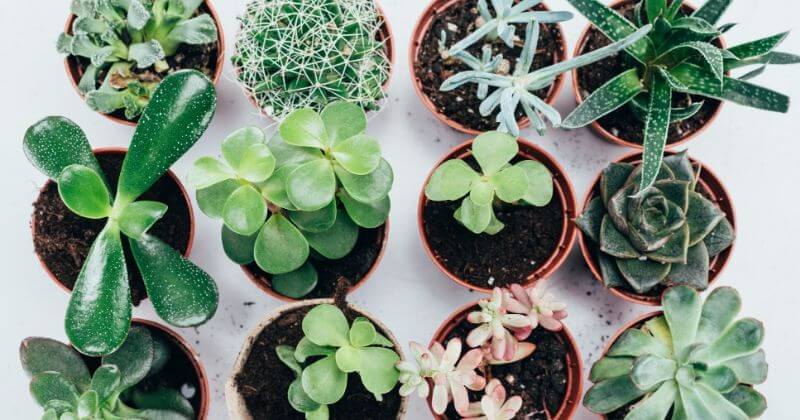
There is nothing quite like succulent plants for adding color and a feel-good factor to a room – not to mention the excellent air-purifying benefits.
If you’re a succulent fanatic with a growing collection, you’re probably starting to think about how to decorate dim area of your home with these gorgeous houseplants.
But can succulents survive in low light conditions? Are they going to be ok in a room that gets minimal sunshine?
You probably already know that most succulents come from hot, arid parts of the world like Mexico and South Africa. The majority of these species need plenty of bright light each day.
Trying to accommodate all your sun-worshipping succulents can lead to overcrowding in prime spots like sunny window sills.
Fortunately, there are a large number of low-light succulents that do just great in your homes and offices which receives little or no natural sunlight. A lot of smaller succulent species evolved to grow in the shade cast by bigger plants or to live in rocky crevices.
These are the little stars you can use to brighten up hallways and North facing rooms short on sunshine.
We’re going to introduce you to 16 of these low-light-loving beauties, but first, let’s discover why at least some light is so crucial for keeping plants healthy.
Why Is Light Important For Succulents?
Do you remember learning about ‘photosynthesis’ in high school science class?
Photosynthesis is a chemical reaction that takes place inside a plant’s leaves. Inorganic substances (water, carbon dioxide, and light) are turned into organic substances that the plant uses to fuel its growth.
Photosynthesis is the plant’s way of making food for itself. Without any light at all, photosynthesis can’t happen, and the plant will eventually die.
Just how much light each plant species needs can vary a lot. Luckily, the species we list below can get by with minimal light.
The Rotation Method
low light succulents can all tolerate low light conditions, but most should not be left in these sun-deprived areas permanently.
Kept in low light, the plant will do well for a couple of months, but then signs of stress will start to appear.
Plants may begin to turn pale and yellow. They may also put on a lot of tall, thin growth as they grow upwards in search of more light.
To Prevent This, We Recommend The Rotation Method.
How does it work? Simply organize your low light succulents into 3 different groups. Group A can be moved to low light areas of your home, while the other two groups (B and C) should be given a home with bright, indirect light.
Ensure Group A plants living in the low light areas are only kept there for a maximum of 3 months out of every 9 months. Once the three months are up, swap them with the plants in Group B.
Once Group B plants have spent 3 months in low light conditions, swap them with the Group C plants. Keep repeating this pattern, and the plants should all stay healthy.
Just remember to set up a reminder, so you don’t forget to switch the groups over!
Replace Regular Light Bulbs With Grow Light Bulbs
Another trick to keep your indoor plants happier if they don’t see much sun is to buy a different type of light bulb.
LED grow light bulbs are low energy and low heat and work in a wide variety of fixed and moveable lighting fixtures.
Place a spotlight with LED bulbs over your most beautiful specimens to create stunning displays in low light corners of your home!
24 Low-Light Succulents That Thrive in Near Darkness
Let’s introduce you to some of the plant genus’ and individual succulent species known to do well in low light conditions.
Here are 24 low-light succulent plants that will thrive in dim and shady homes and offices, where they don’t get much bright sunlight.
1. Aloe (Asphodelaceae)
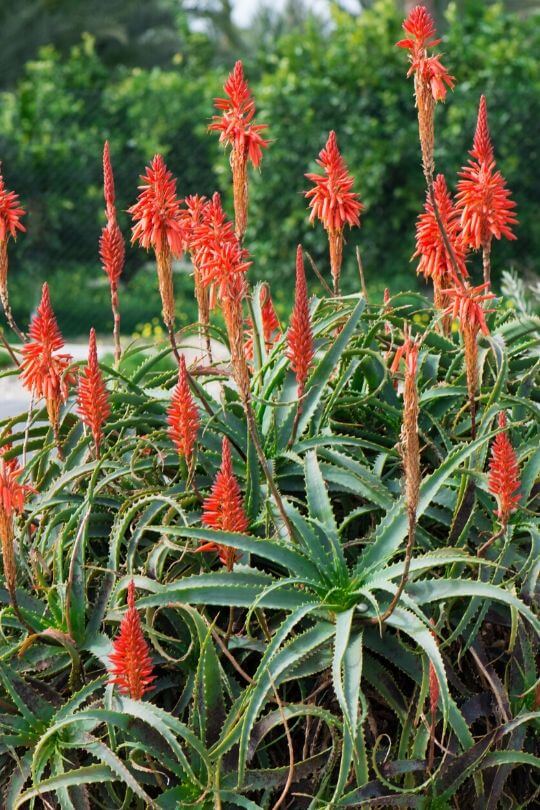
The humble medicinal or ‘healing’ Aloe is just one of a huge genus. The genus is home to all shapes and sizes of plants – some species are monsters that can reach up to 30ft tall!
Aloes available as house plants are usually the dwarf types. Larger species tend to do better out of doors, as long as you protect them from frost.
Smaller Aloes in the wild spend a lot of time in the shade, which makes them a great candidate for a room with low light.
Flowers are unlikely if growing Aloes in low light, but they are still striking, shapely plants in their own right.
Aloes are also simple to propagate as they freely create offsets (smaller clone plants) at the base of the main stem.
Here are some handsome Aloe species we recommend for low light areas:
2. Aloe X ‘Doran Black’
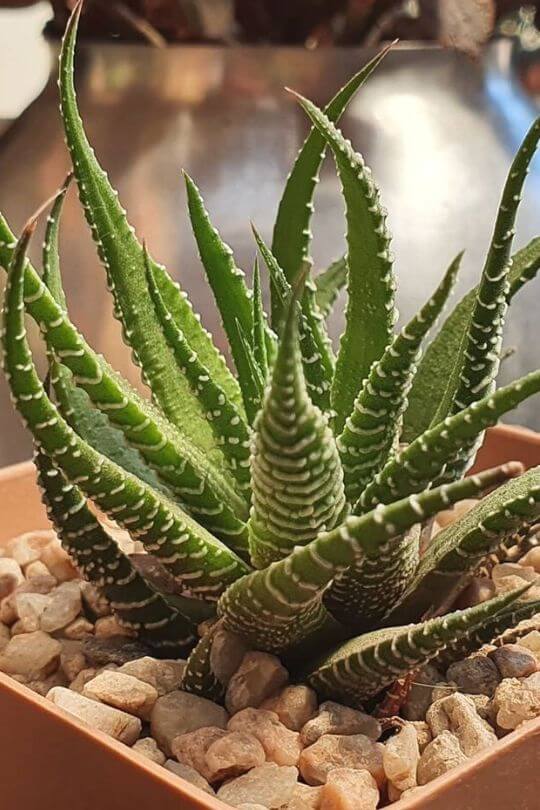
Doran Black is a super cute dwarf Aloe that won’t take up much room in your collection. It’s also a very low maintenance plant, demanding very little attention from you beyond occasional watering.
This mini succulent has chunky leaves that form attractive, spiky rosettes. Each leaf is patterned and textured all over with creamy, rough-textured nubs that look like small scales.
Like many other Aloes, ‘Doran Black’ does not seem to mind being placed in a low light setting for a short period.
Just make sure it is rotated to a brighter position in your home for at least six months out of every nine.
3. Aristaloe Aristata
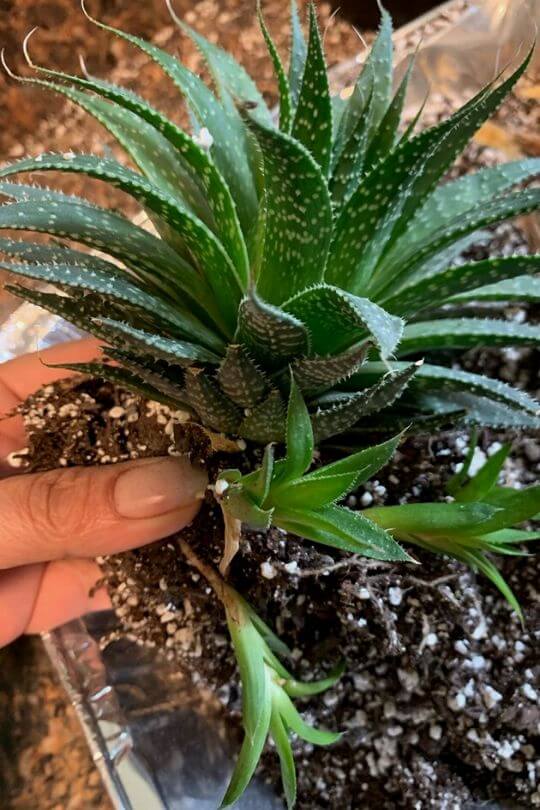
The Lace Aloe is a supremely stylish little houseplant. The petite rosettes of spiky leaves feature many hundreds of tiny white bumps.
The leaves taper to a fine point, giving the Lace Aloe a delicate and dainty appearance. It looks particularly lovely when planted in a ball-shaped planter.
One great thing about the Lace Aloe is that it grows quickly, so you won’t have to wait long for it to reach adulthood.
Although Lace Aloes generally prefer bright light, they can get along ok in a low light area for a temporary period.
4. Gonialoe Variegata (Tiger Aloe)
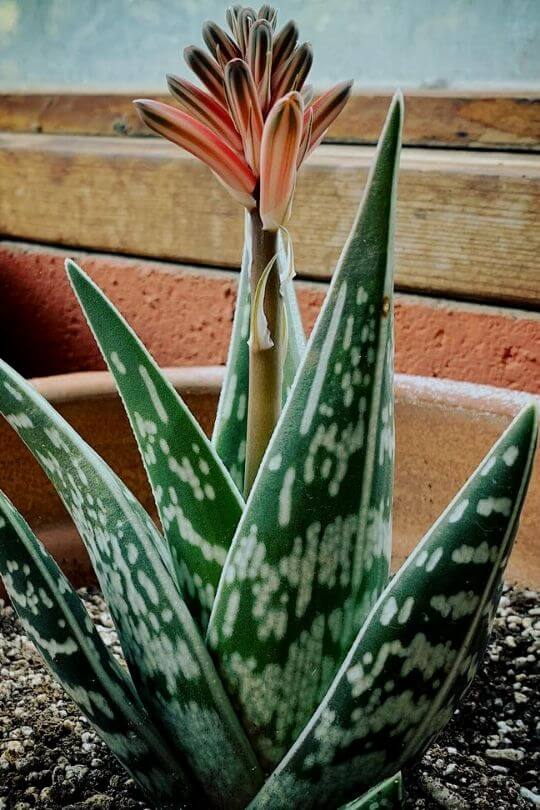
The Tiger Aloe forms sturdy, smart-looking rosettes of thick, triangular leaves. The plant has beautiful, random patterns of white flecks and dots.
You don’t have to worry about any sharp spines with this species – the ridges along each leaf are blunted. The Tiger Aloe is one type of Aloe that won’t struggle in low light settings and can even cope quite well under fluorescent light.
In its native land of South Africa, the local Afrikaans word for this Aloe is ‘Kanniedood’ which means ‘cannot die’. Locals were impressed by its ability to survive prolonged droughts!
The Tiger Aloe is an excellent plant for the more forgetful owner and won’t make you pay if it gets neglected from time to time.
5. Senecio (Asteraceae)
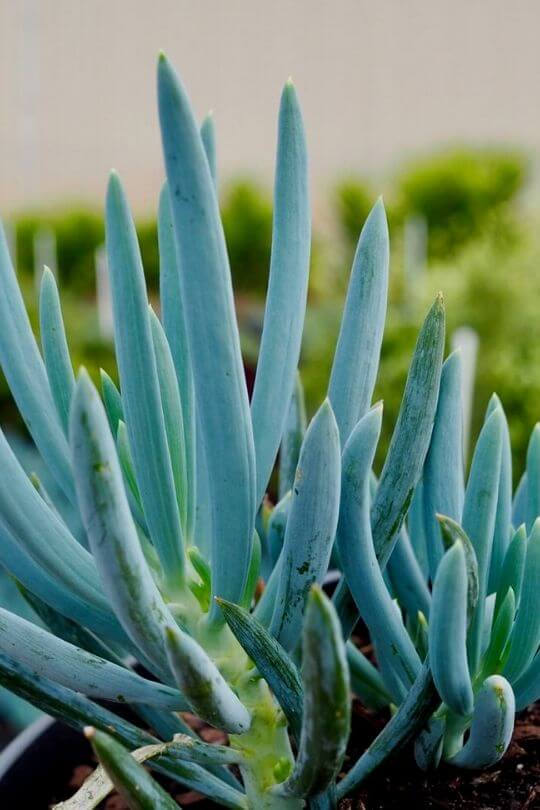
The Senecio genus includes over a thousand different species from Africa, Madagascar, Mexico, the Canary Islands, and the East Indies. The name ‘Senecio’ means old man.
The plant types vary widely, but several of the unusual succulent species make fantastic houseplants. Some of these species also have the added benefit of growing well in low light levels.
Let’s take a look at a few now.
6. Senecio Radicans (String Of Bananas)
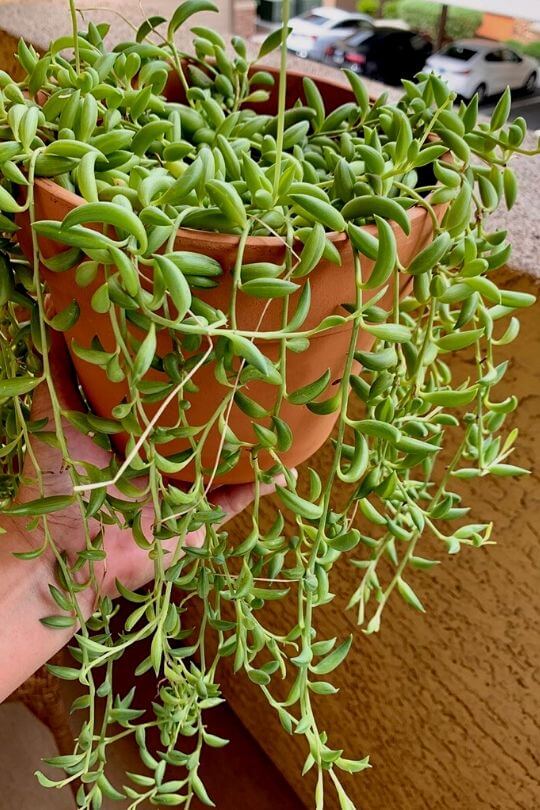
The tropical Senecio radicans is one of our favorite succulents! Its gorgeous trailing stems hold hundreds of fat, banana-shaped leaves.
String of Bananas, as it is affectionately known, looks gorgeous hanging from a wall-mounted pot or hanging basket. It’s no wonder that this unusual succulent is so popular.
Just make sure to keep it out of reach of children and pets who might want to play with the juicy leaves. Although they look good enough to eat, the leaves are toxic.
Unlike the closely related species ‘String of Pearls’, Senecio radicans are easy to grow. They need minimal maintenance and do well even in lower light conditions.
Use the rotation method and give them brighter light for six out of every nine months.
7. Senecio Articulatus (Candle Plant)
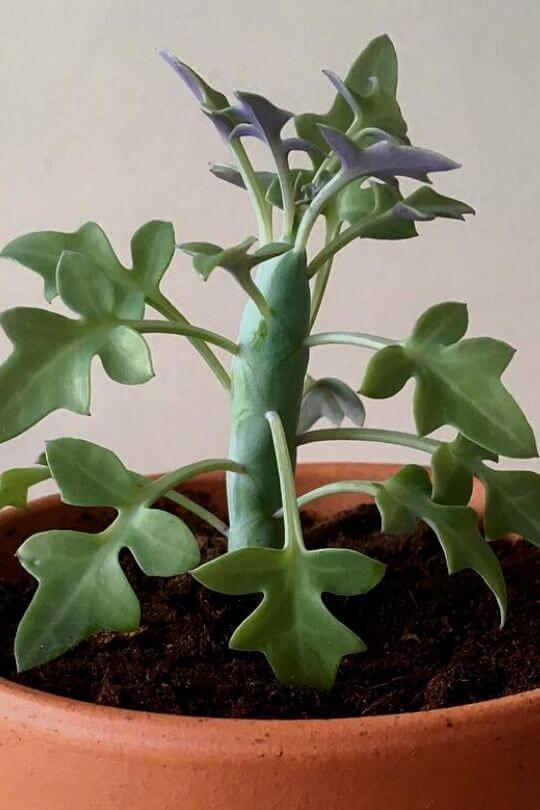
Senecio articulatus is a weird and wonderful succulent with lots of personality! The narrow, grey-green, articulated stems grow upwards like knobbly alien fingers.
Your Candle Plant may also produce small, lobed, arrow-shaped leaves at the end of each stem, although it’s not guaranteed.
Once established, Candle Plants can survive on tiny amounts of water. It also seems to be quite content growing in low light locations.
8. ECHEVERIA (Crassulaceae)
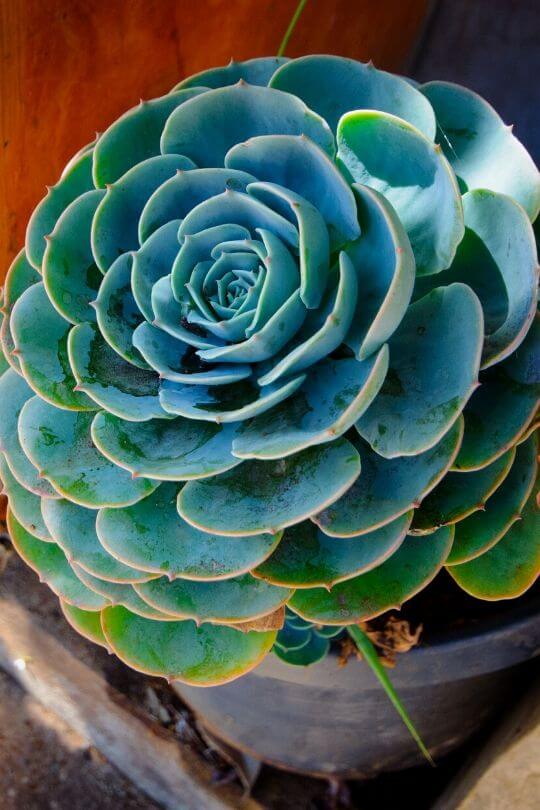
It’s highly likely you already have an Echeveria in your succulent collection. These little rosette-shaped plants are widely available and incredibly popular. Visit any garden or home store, and you’re sure to find a few baby Echeverias in pots for sale.
Originally from Mexico and north-west South America, most Echeveria species are compact, short-stemmed, rosette-shaped succulents. A wide range of colors and leaf shapes are available, thanks to the introduction of many new hybrids.
Many Echeveria species dislike lots of sun, making them lovely little decorative plants for shady corners of the home. The ones that do best in the shade tend to be the solid, green-colored varieties, so look out for these when you go plant shopping.
A problem with this compact type of succulent living in low light can be some amount of stretched-out growth. We would recommend that your Echeverias are put into a rotation system with your other low light succulents to prevent this.
9. Echeveria Agavoides (Molded Wax Agave)
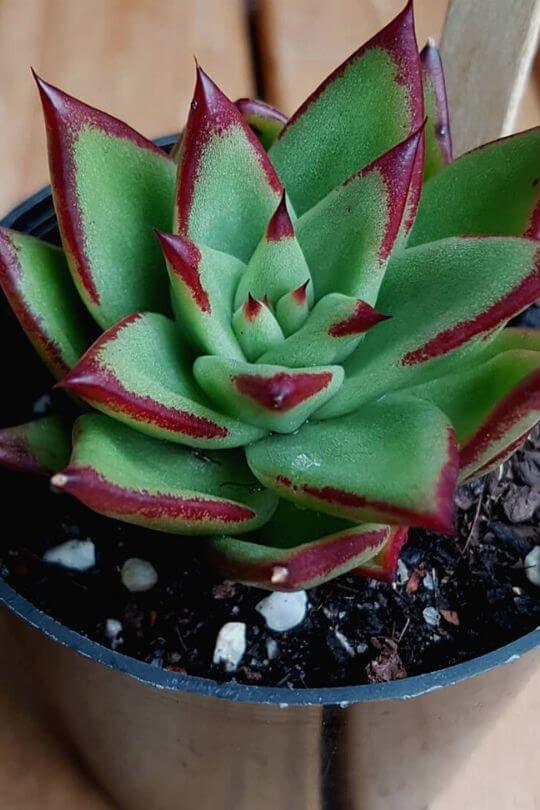
This smart little succulent is also known as the Lipstick Plant.
Echeveria agavoides should do just fine in a low light setting as long as it is not there permanently. It won’t ask you for much space either, as it only reaches 5 inches in height.
This little beauty’s leaves are plump and juicy and marked with dashes of bright red on the leaf tips. The chunky, triangular leaves make it look like an Agave plant, which explains the Latin name.
Unfortunately, low light conditions may reduce the amount of red pigment on your lipstick plant. It’s not usually prone to stretching out, though, so it should stay in a nice, compact rosette form.
Quick Facts
10. Crassula (Crassulaceae)
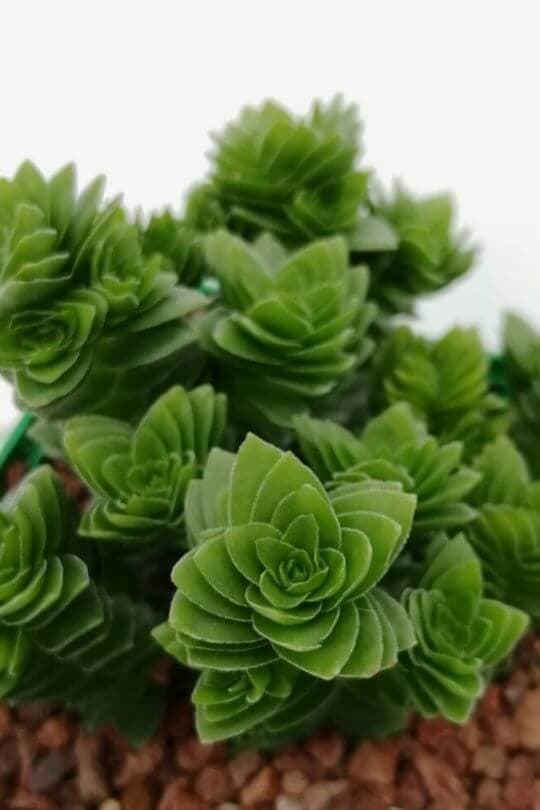
As well as the popular ‘Jade Plant’, this genus includes a wide range of species originating from South Africa.
Crassula species are easy to grow and will survive in conditions that would soon finish off other succulents. Short periods of low light won’t phase your Crassula plants but deprive them of light for too long, and they may develop leggy growth.
11. Crassula Ovata (Jade Plant)
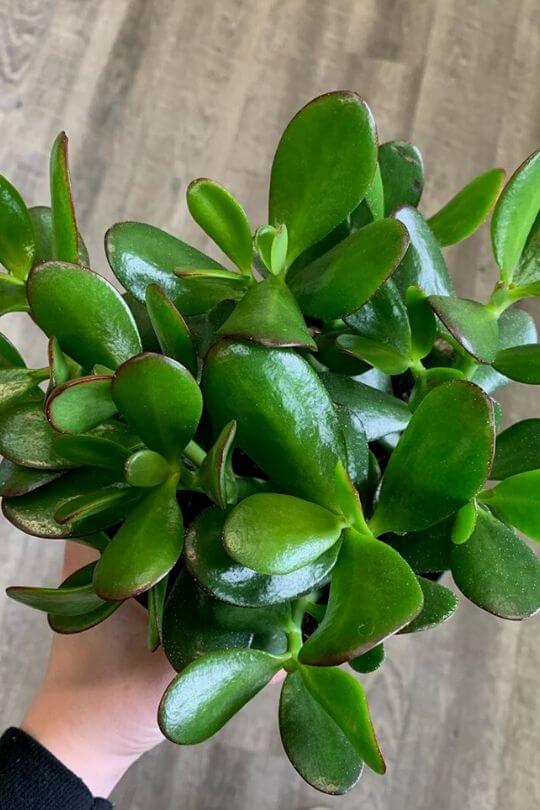
This incredibly popular species is versatile and can adapt to life in all sorts of conditions.
One reason it’s so popular is that it’s straightforward to propagate! Simply pick a leaf off the stem and pot it up to create new plants. They make great little gifts for friends and family.
Jade Plants are easy to shape into attractive forms. The woody stems make them great candidates for bonsai, although the dwarf Jade plant Portulacaria afra may be a better option for this.
Quick Facts
12. Crassula Ovata ‘Gollum’ (Finger Jade)
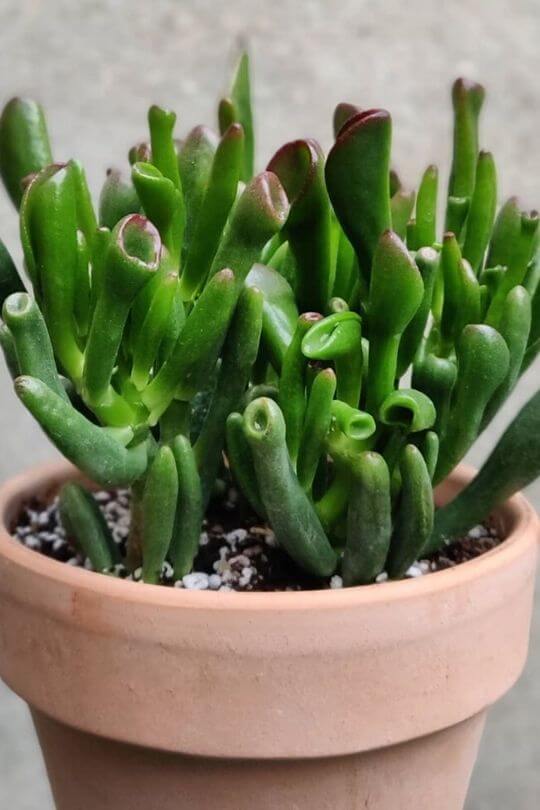
The ‘Gollum’ plant is a weird and wonderful succulent that looks more like something that should be growing on a coral reef than in a garden!
Narrow tubular, tentacle-like leaves form a tight cluster in the young plant, but over time the Gollum can take on more of a tree-like appearance and reach up to three feet in height. The ‘tube’ tips are usually tinted red.
Much like its namesake from the Lord of the Rings books, the Gollum plant can survive quite happily in low light areas.
Quick Facts
13. Haworthia (Asphodeliaceae)
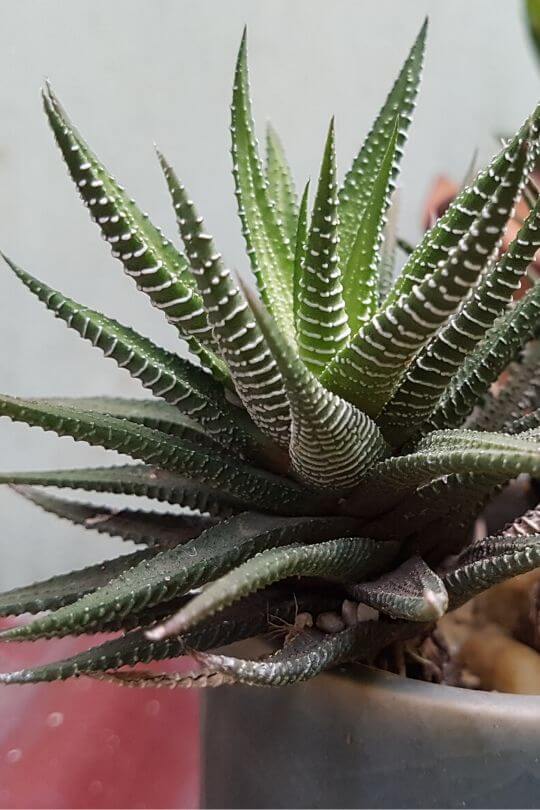
This genus boasts a whole host of beauties you’ll want to add to your succulent collection. Most Haworthia species form rosettes with thick fleshy leaves.
Like their Aloe relatives (and many other succulents), Haworthia originates from Southern Africa.
In the wild, Haworthia love to hide away in rocky crevices or among bushes. They would rather stay out if the sun and this preference is what makes them ideal houseplants for shadier rooms.
When choosing a Haworthia to decorate a low light area, look for a species with thinner leaves. These types tend to do better with reduced amounts of sunshine.
Thanks to Haworthia’s popularity, you should be able to find a wide range of hybrids and variegates online or at local plant nurseries.
Thanks to their fun and jazzy looks, Haworthia plants work well in bold and modern, geometric style pots.
14. Haworthia Limifolia (Fairy Washboard)
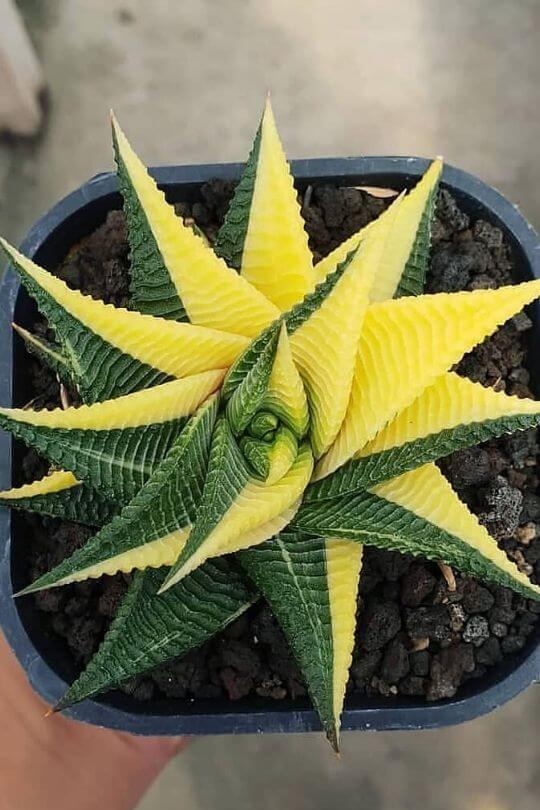
The Fairy Washboard is a cute little succulent that will barely reach 4 inches in width when fully grown. The small rosettes consist of fleshy leaves with neat ridges of paler bumps.
The bumps on the leaves form little rows that look a little like a traditional washboard.
Each leaf is broad at the base and then tapers to a delicate point, creating a pretty pin-wheel effect when viewed from above.
Like many Haworthia, the Fairy washboard dislikes full sun and is much happier living in partial shade.
Quick Facts
15. Haworthia Reinwardtii (Zebra Wart)
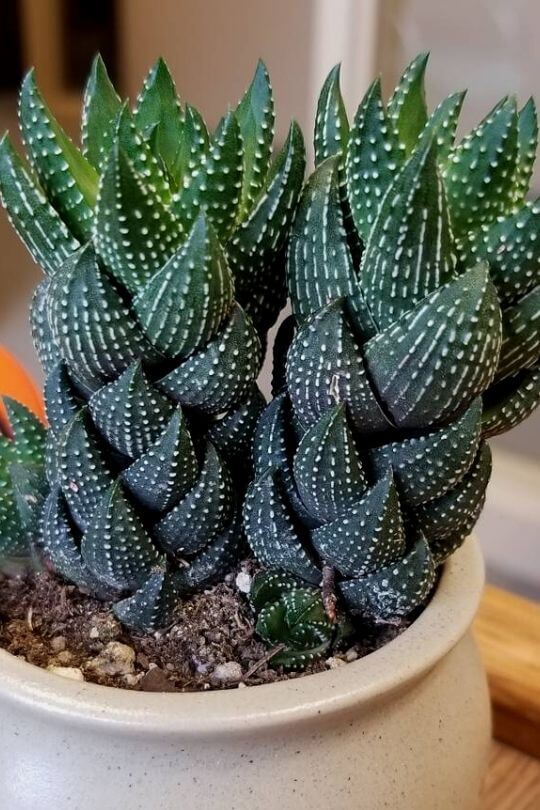
The Zebra Wart likes to form neat little columns, making it a nice change from the Aloe type shape that many Haworthia species resemble.
Its fleshy leaves narrow towards the tip, pointing upwards and inwards rather than splaying outwards. Neat rows of small white bumps decorate the outside of the leaves.
The Zebra Wart makes a super little houseplant, tolerating low light and thriving on neglect.
If you want more of them (and who wouldn’t?), they are sure to produce lots of offsets for you to plant up.
Quick Facts
16. Haworthia Margaritifera (Pearl Plant)
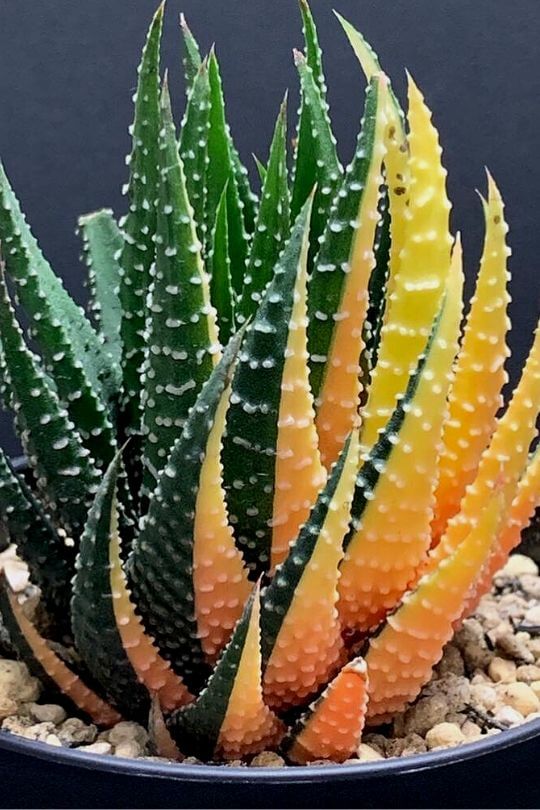
The rich and dark blue-green leaves of this lovely species have tiny white bumps all over. Even for a succulent, these little plants are chubby and adorable!
The Pearl Plant makes a showy feature plant with minimal care requirements. Even if you think you have black thumbs, we recommend you give this species a shot!
17. Kalanchoe (Crassulaceae)
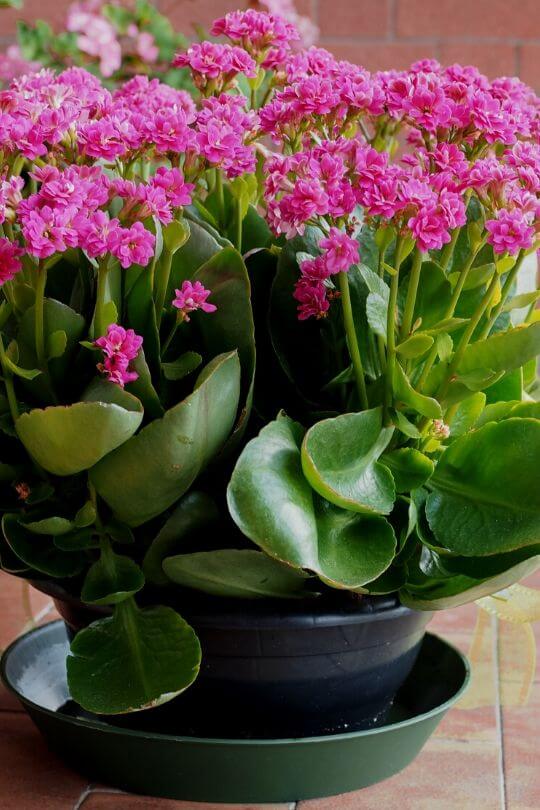
Flora and fauna from Madagascar are famous for being cool and unusual, and the Kalanchoe genus is no exception!
Some Kalanchoe species also go by the common name ‘Mother of Thousands.’ This is because they produce hundreds of tiny plantlets along the edge of their mature leaves.
Although this makes them a breeze to propagate, it can also be a nuisance as the tiny new plants get everywhere!
Kalanchoes are often grown for their gorgeous flowers, which come in shades of pink, red, orange, or white. Many species of Kalanchoe do well in lower light conditions.
Here are a couple that we recommend.
18. Kalanchoe Tomentosa (Panda Plant)
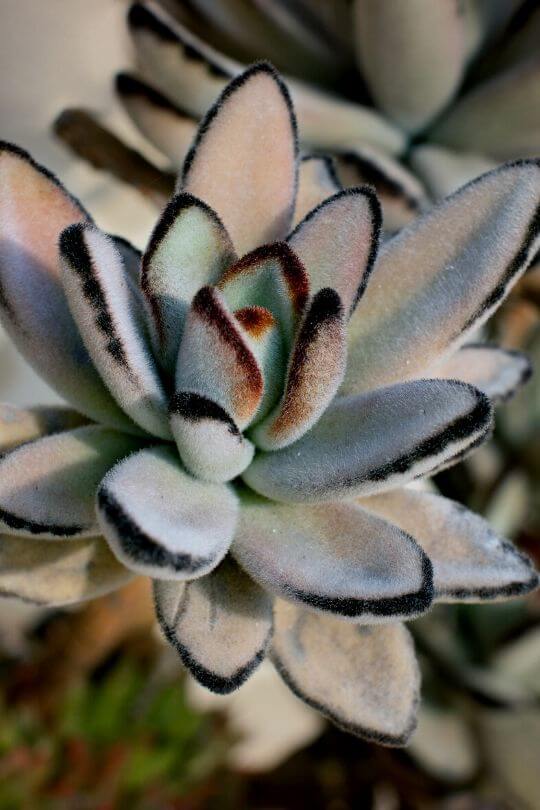
The Panda Plant is famous for the gorgeous, furry texture of its leaves. They are super soft and velvety to touch. This unusual feature helps explain how it acquired another of its common names: Pussy Ears!
The plant’s ‘fur’ is made up of lots of tiny hairs. Panda Plants color is usually an almost ghostly grey-blue, complemented by rich brown markings on the leaf margins.
We recommend finding a dark plant pot to contrast with the pale leaves of your Panda Plant.
Although the Panda Plant won’t thrive in low light conditions in the long term, it will do fine for short periods.
Use the rotation method to ensure the plant spends only 3 out of every 9 months in darker areas of the house.
Quick Facts
19. Kalanchoe Thyrsiflora (Paddle Plant)
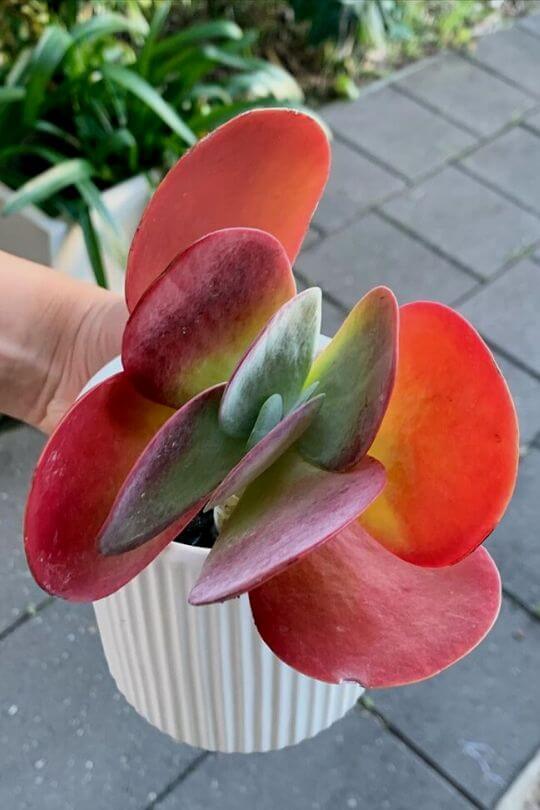
Hailing from South Africa, where it is also known as the Cabbage Plant, the Paddle Plant has big round leaves. It can make a beautiful, bold contrast to the daintier species of succulent.
The striking red leaf margins are normally only seen if the plant gets plenty of sunshine. But the paddle will look attractive in the shade too.
In low light, a powdery white bloom turns the leaves a soft grey-green color.
Quick Facts
20. Zamiacaulcus (Araceae)
This African genus of succulents forms large tubers in the soil. Impressive long green leaves appear from the top of the tuber.
The wider plant family Araceae is well known for including species with revolting smelling flowers. Thankfully though, that’s not the case with Zamiacaulcus!
The best thing for new plant parents is that this genus of plants is extremely tolerant of poor care.
You can throw it in full sun or low light, over water it or underwater. Somehow the Zamiacaulcus takes it all in its stride!
21. Zamiacaulcas Zamiafolia (ZZ Plant)
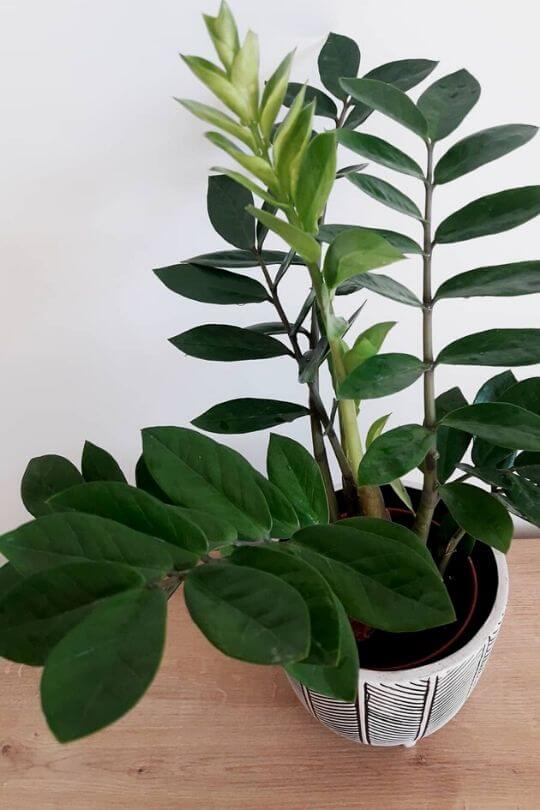
The ZZ Plant is a real godsend for gardeners with black thumbs. You could call it a tough cookie! You have to really go out of your way to kill these plants, as they tolerate almost any variety of conditions.
The ZZ Plant can reach up to 3 ft, and with it’s shapely, glossy, long leaves, it makes a lovely focal point in a low-light room.
Low light levels are no problem for the ZZ Plant, and it will even grow well in fluorescent light. What a champ!
Quick Facts
22. Sansevieria (Agavaceae)
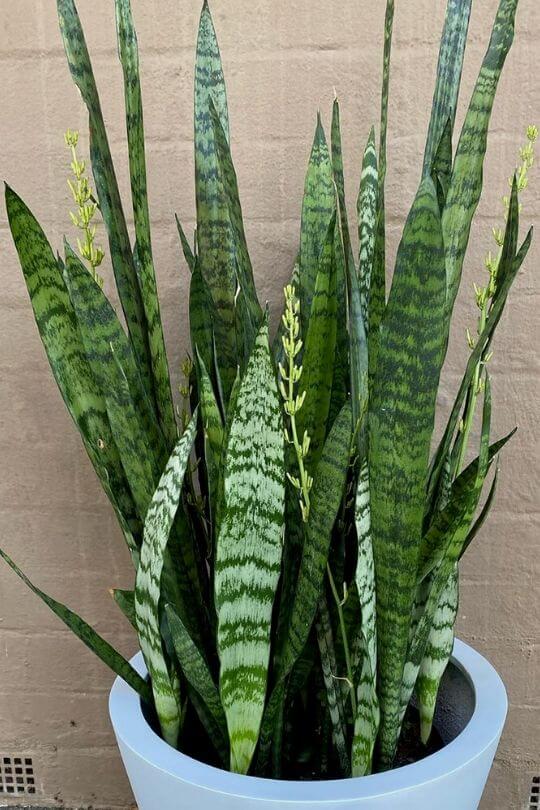
The African Sansevieria genus is responsible for giving us some superb house plants. Many species are happy to tolerate low light and low water levels and make an excellent choice for dingy rooms.
The leaves of Sansevieria are usually long, upright, and fleshy. There are lots of attractive hybrids and variegated options to choose from. Let’s introduce you to some of the best species for a low light setting.
23. Sansevieria Parva (Kenya Hyacinth)
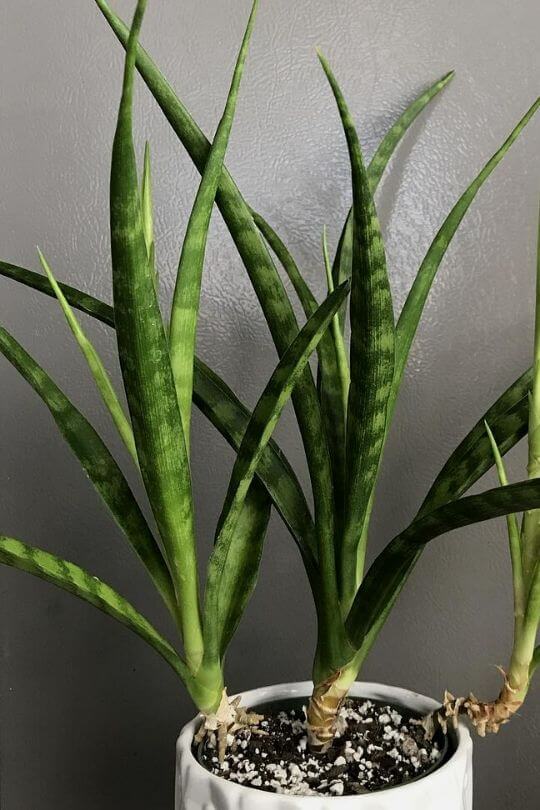
The Kenya Hyacinth has long, narrow leaves that grow in a clump that gives the effect of a lush grass rather than a succulent. The leaves are fleshy, though, and come in a bright, vivid green with darker green stripe markings along each one.
Unfortunately, the lovely scented flowers which give it its common name are unlikely to appear in low light, but you can use it to add some lush, attractive greenery to a low light corner of the home.
Quick Facts
24. Sansevieria Trifasciata (Mother-In-Law’s-Tongue)
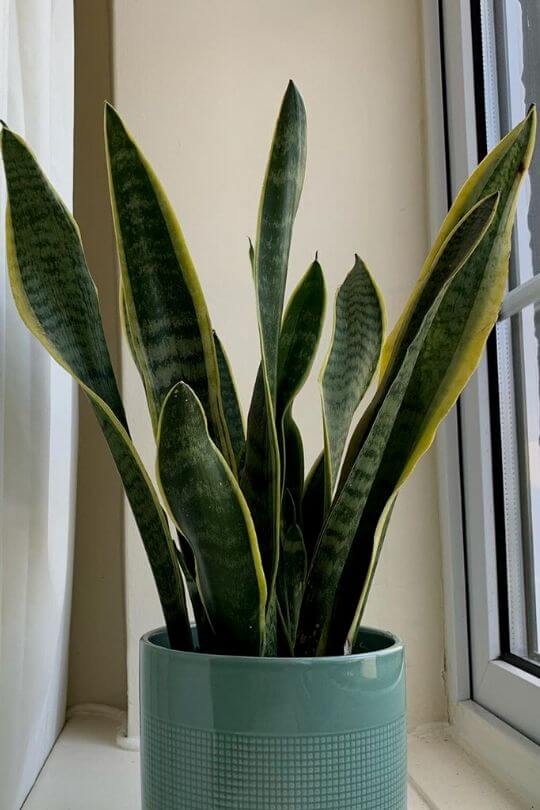
Sansevieria trifasciata is a hugely popular house plant and for good reason! Also known as ‘Mother-in-Law’s-Tongue,’ this striking succulent creates a bold statement in any room.
The long, upright leaves can reach up to 1 meter in height and grow very fast. Each one features gray-colored bands in the center, and pale yellow edges.
Quick Facts
Start Planning Your Indoor Succulent Shade Garden
So now we know that there are plenty of fabulous succulent species you can use to decorate your dingy hallways and sunshine deprived rooms.
From the dainty rosettes of Haworthia, to the statuesque beauty of the ZZ plant, there’s a shape and style of plant to suit every taste and room design.
Just remember to give your succulents good drainage and not to overwater them as root rot is a far bigger danger to their health than reduced sunshine.
What are you waiting for? It’s time to plan your indoor ‘shade garden’ and brighten up those dark areas with some lush and juicy succulents!
Happy gardening!

Written By
Amber Noyes
Amber Noyes was born and raised in a suburban California town, San Mateo. She holds a master’s degree in horticulture from the University of California as well as a BS in Biology from the University of San Francisco. With experience working on an organic farm, water conservation research, farmers’ markets, and plant nursery, she understands what makes plants thrive and how we can better understand the connection between microclimate and plant health. When she’s not on the land, Amber loves informing people of new ideas/things related to gardening, especially organic gardening, houseplants, and growing plants in a small space.
